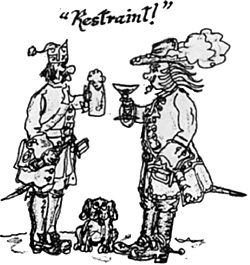
Horror at the excesses of the Thirty Years War, and the rise of professional standing armies made warfare a comparatively subdued pastime from the late seventeenth century up until the French Revolution and the introduction of massive "citizen" armies.
For want of a better name, we might call it the "Age of Restraint." It holds a special charm for today's armchair general, 3nd a special empathy. Indeed, the attitudes of today's table top commanders and most generals of the "Age of Restraint" are remarkably similar.
Both command armies of professional soldiers, whether flesh and blood or tin. Training, uniforms, and tactics are rigidly controlled by the commanding officer, and the rank and file are not likely to talk back.
 Morgan's 11th Va. Riflemen defending Pitcairn's Hill during a recent game. Next issue we will cover the full battle of the town of Schulyer with text and photos. (photo by Bob Milillo)
Morgan's 11th Va. Riflemen defending Pitcairn's Hill during a recent game. Next issue we will cover the full battle of the town of Schulyer with text and photos. (photo by Bob Milillo)
Metal or mortal, the are less unpredictable than the raw levies of earlier and later periods, and in real and mock warfare of this era there is a certain dash and charm less brash and overdone than that of most of the gilded vulgarians of Napoleon's day.
Iron (or, if you prefer, lead or plastic) discipline is the rule in the armies of the 'Age of Restraint." Frederick the Great, who, along with Marlborough and Eugene of Savoy stands as one of the great captains of the day summed it up quite simply: "The commander should practice kindness and severity."
And, in varying degrees, all armies of the period did, with the exception of semi-disciplined levies such as the Croats and Pandours of the Austrian Army, the Cossacks and some raw Russian units in foriegn territory, and, under bad commanders, whole French armies (unfortunately, after the death of Louis XIV, France experienced a bumper crop of bad commanders.)
Action took place from Africa and the Indies to the wilds of Canada, and the variety although restrained, is immense.
The purpose of the series of articles which this brief piece prefaces is to examine some of the colorful troops, engagements, and commanders of the "Age of Restraint" and to catalogue figures and accessories from all over the world to depict them.
And, as I once pointed out in an article for Don Featherstone "Wargamer's Newsletter":
- "Once the average wargamer has gotten Waterloo, Gettysburg and the Marne out of his system, he may seek a period in which military history offers something in the way of contrasts and variety.
"While the great standards of wargaming, some of which are mentioned above, have received more than their share of treatment, the untrodden paths in wargaming are still virtually ignored.
"...In this relatively brief span (1680-1789) in which some historians would have us believe that concepts and modes of warfare remained static and dill, an intriquing variety of small and specialized wars and campaigns is available."
I will deal with some of then in coming issues of "The Armchair General."
The views expressed by Mr. Bakshian do not necessarily reflect those of the remainder of the staff. Frankly, I am of the opinion that the Napoleonic era saw many changes of value to the wargamer and collector, most especially in the elimination of those blasted three cornered hats.
Back to The Armchair General Vol. 1 No. 1 Table of Contents
Back to The Armchair General List of Issues
Back to MagWeb Master Magazine List
© Copyright 1968 by Pat Condray
This article appears in MagWeb (Magazine Web) on the Internet World Wide Web. Other military history articles and gaming articles are available at http://www.magweb.com
